Abstract
In 17 adults, serum, hepatic bile, and saliva samples were analyzed for their sedimentation profile of IgA and secretory component (SC), and for their concentrations of albumin, orosomucoid, transferrin, IgG, IgA, alpha 2-macroglobulin (alpha 2M), IgM, and SC. Polymeric IgA(p-IgA) averaged 13% (50-700 micrograms/ml) of total IgA in serum, 70% (43-88%) in bile, and 93% (74-98%) in saliva. Most of the p-IgA in bile sedimented with SC, which also occurred free (8-44%), and with IgM. In bile, albumin (155-1,485 micrograms/ml) was the predominant protein, followed by IgG (32-480 micrograms/ml), and total IgA (37-209 micrograms/ml). In saliva, p-IgA (72-902 micrograms/ml) predominated, followed by albumin (16-385 micrograms/ml) and IgG (9-178 micrograms/ml). Secretion-to-serum albumin-relative concentration ratios (S/S-ARCR = 1 for albumin) in bile averaged 22 for p-IgA, 1.91 for IgM, 1.28 for monomeric IgA (m-IgA), 0.70 for IgG, and 0.57 for alpha 2M, indicating for p-IgA, IgM, and to a lesser extent for m-IgA, a selective excretion into bile. In saliva, a 16-fold greater selective excretion of p-IgA (mean S/S-ARCR = 354) was found. Labeled m- and p-IgA were injected intravenously into five patients. Specific activities indicated that for p-IgA 50% was serum derived in bile, as compared with 2% in saliva, and to 85% for m-IgA in bile. In the patient with the highest excretion of 125I-p-IgA in bile, only 2.8% of the injected dose was recovered in bile within 24 h after injection. Compared with rats and rabbits, the serum-to-bile transport of p-IgA in humans is much smaller.
Full text
PDF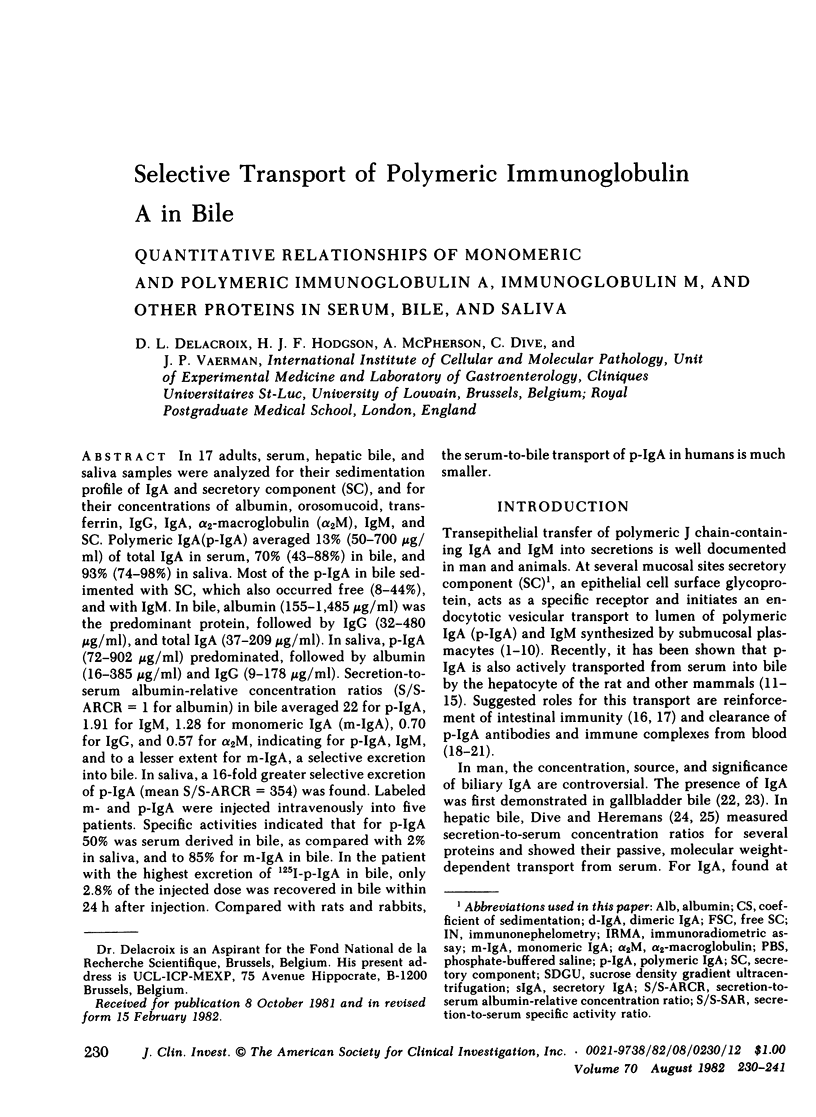
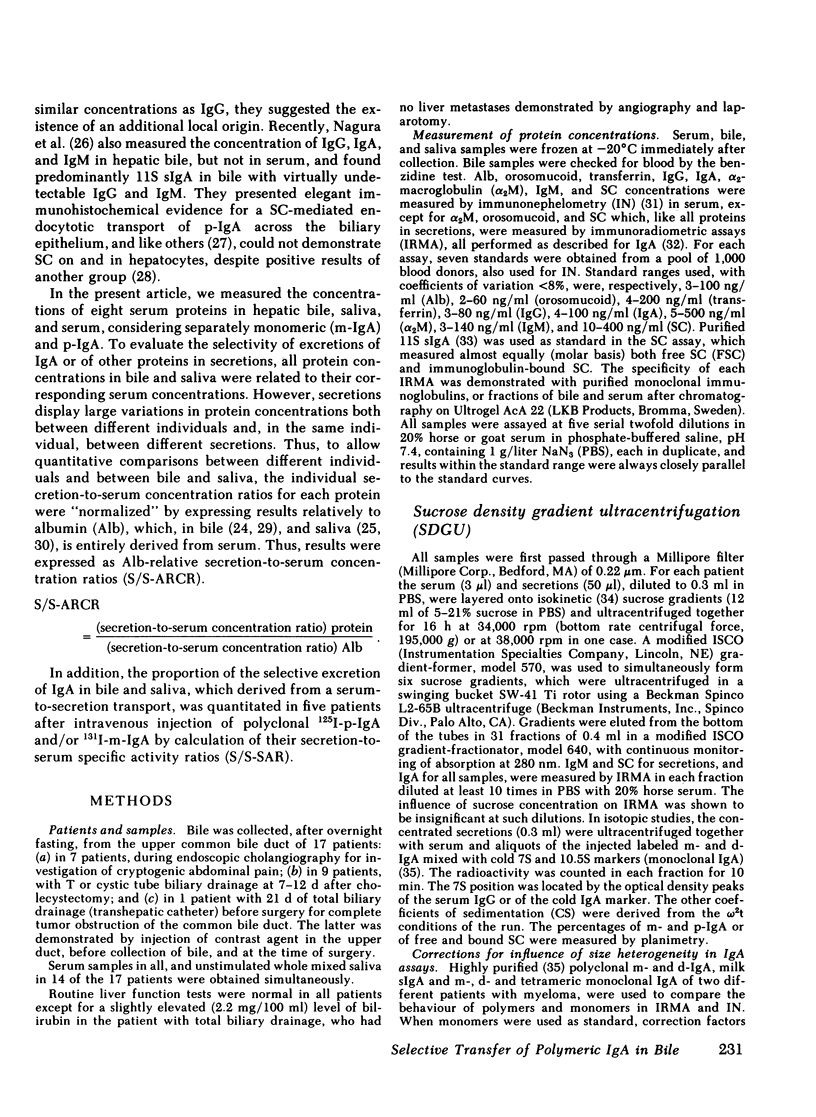
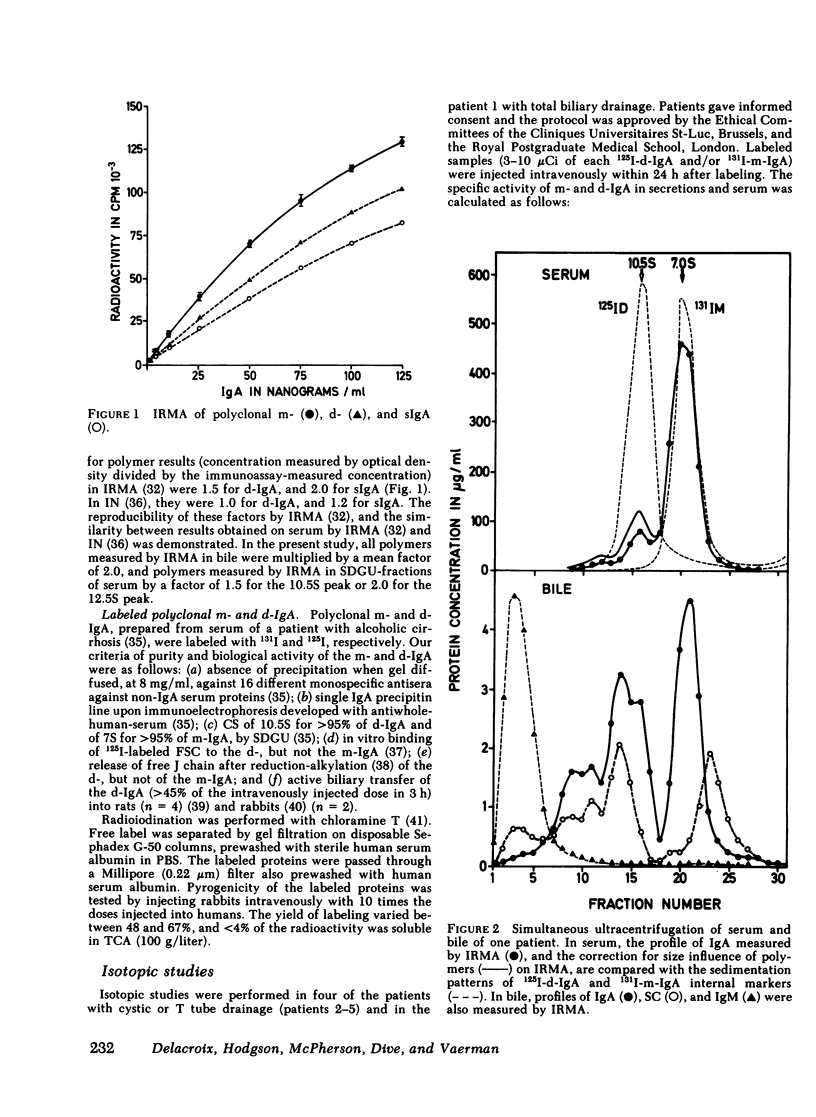
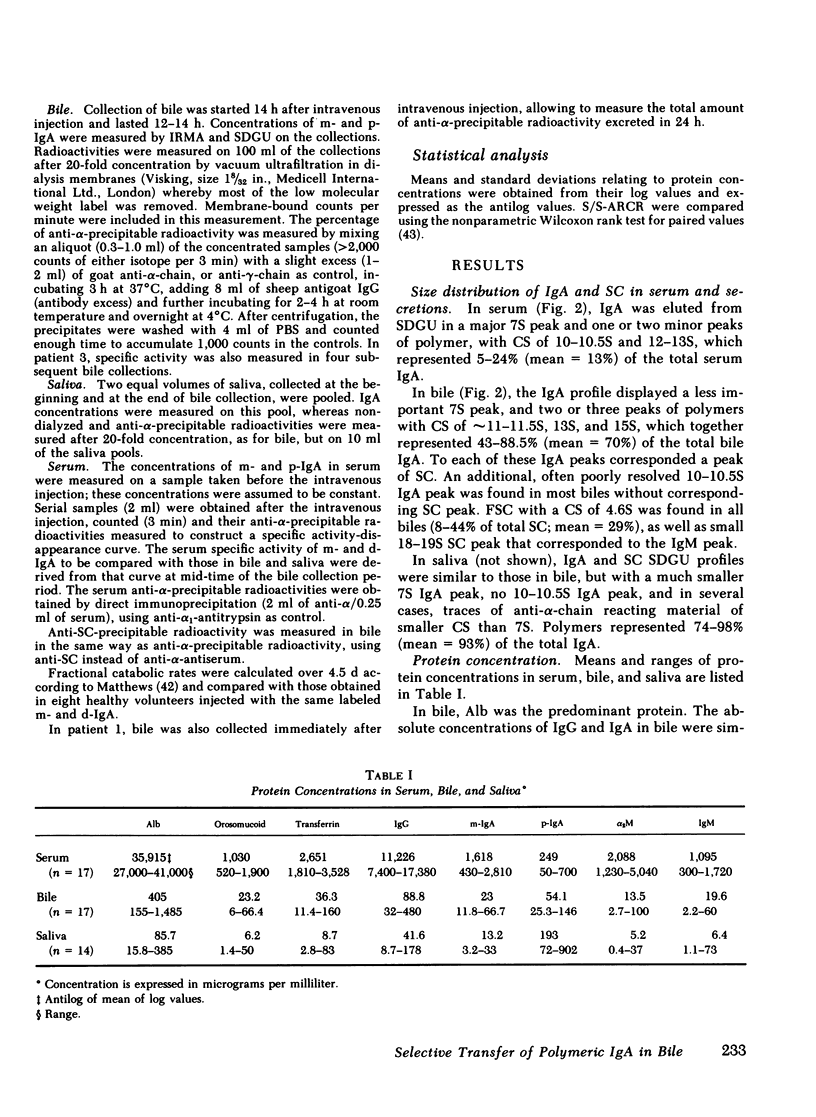
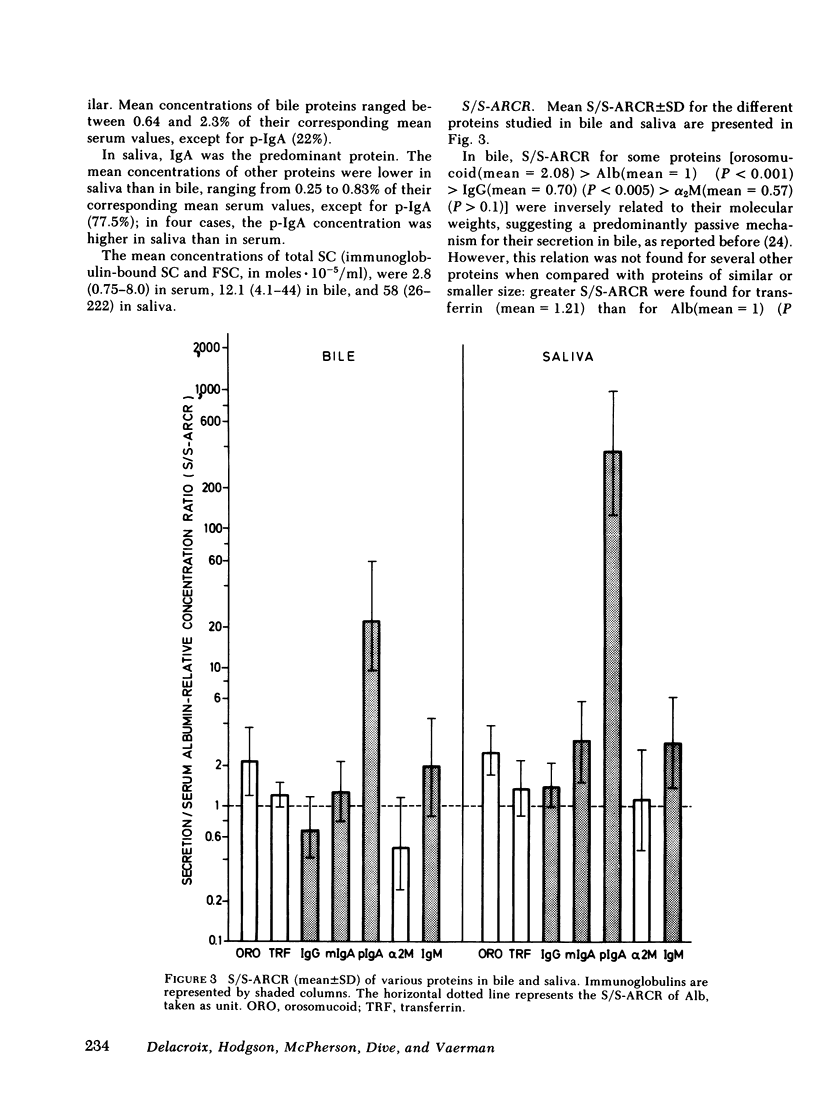
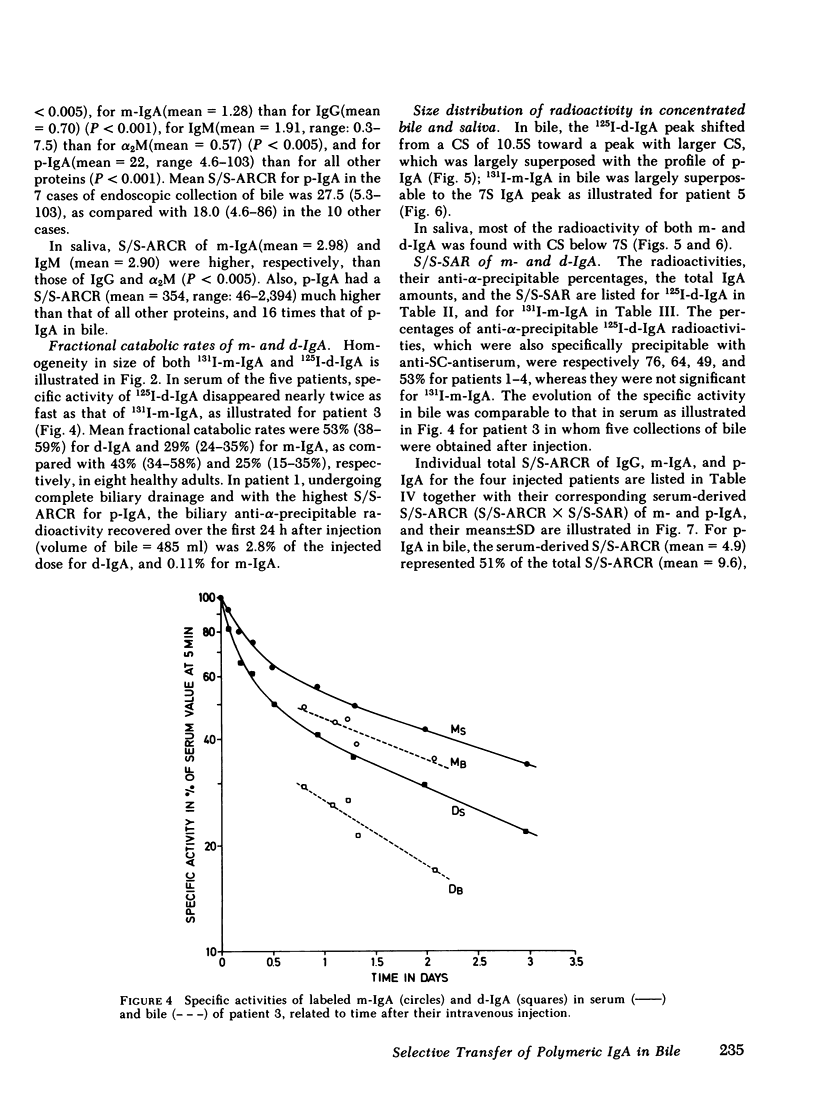
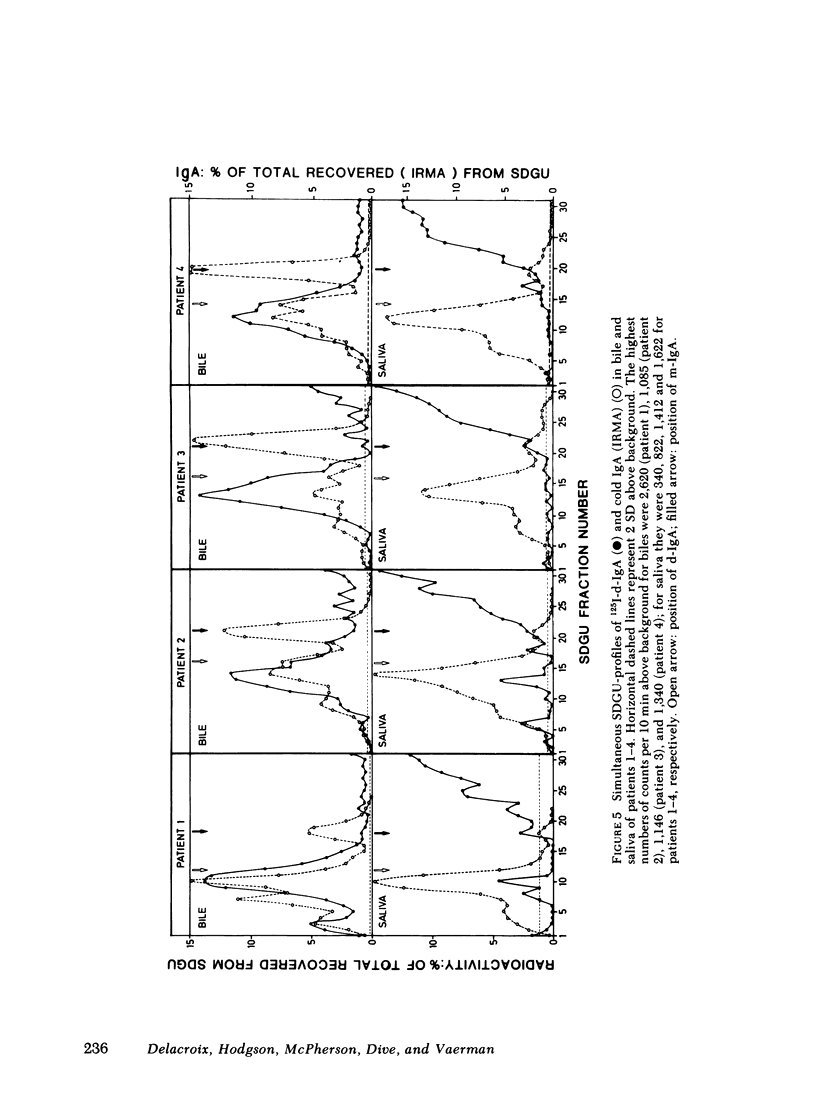
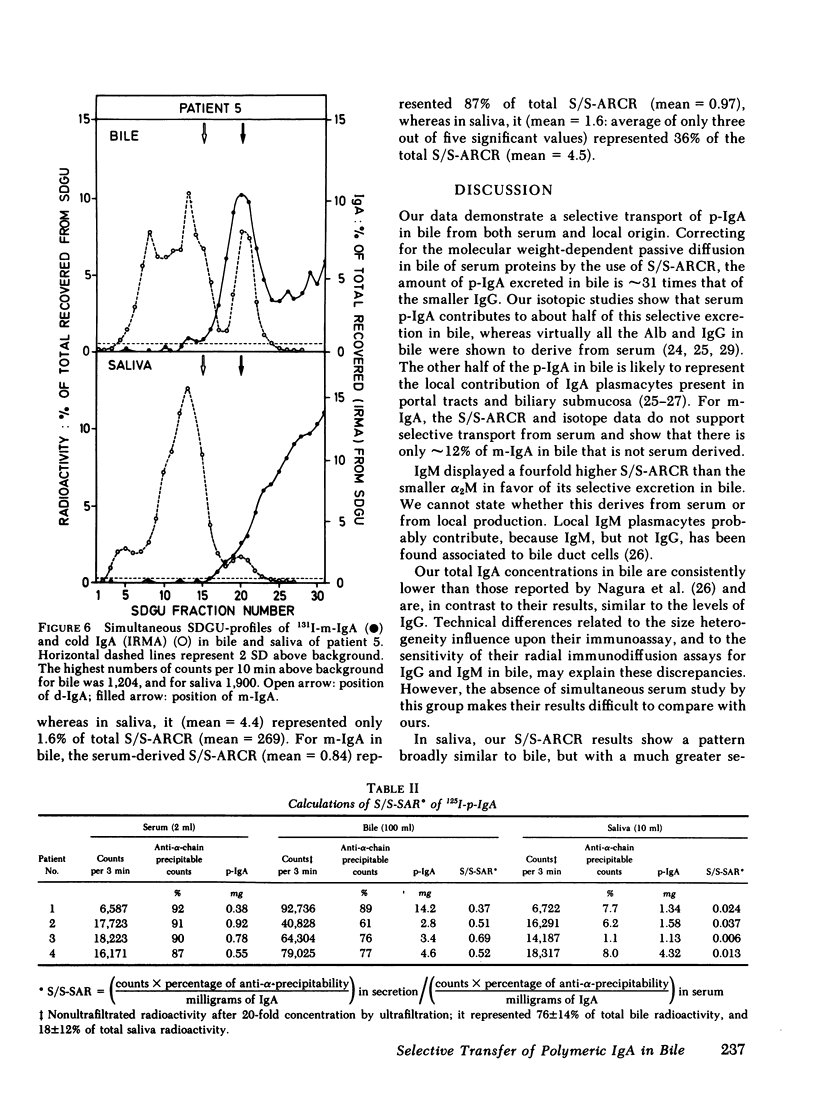
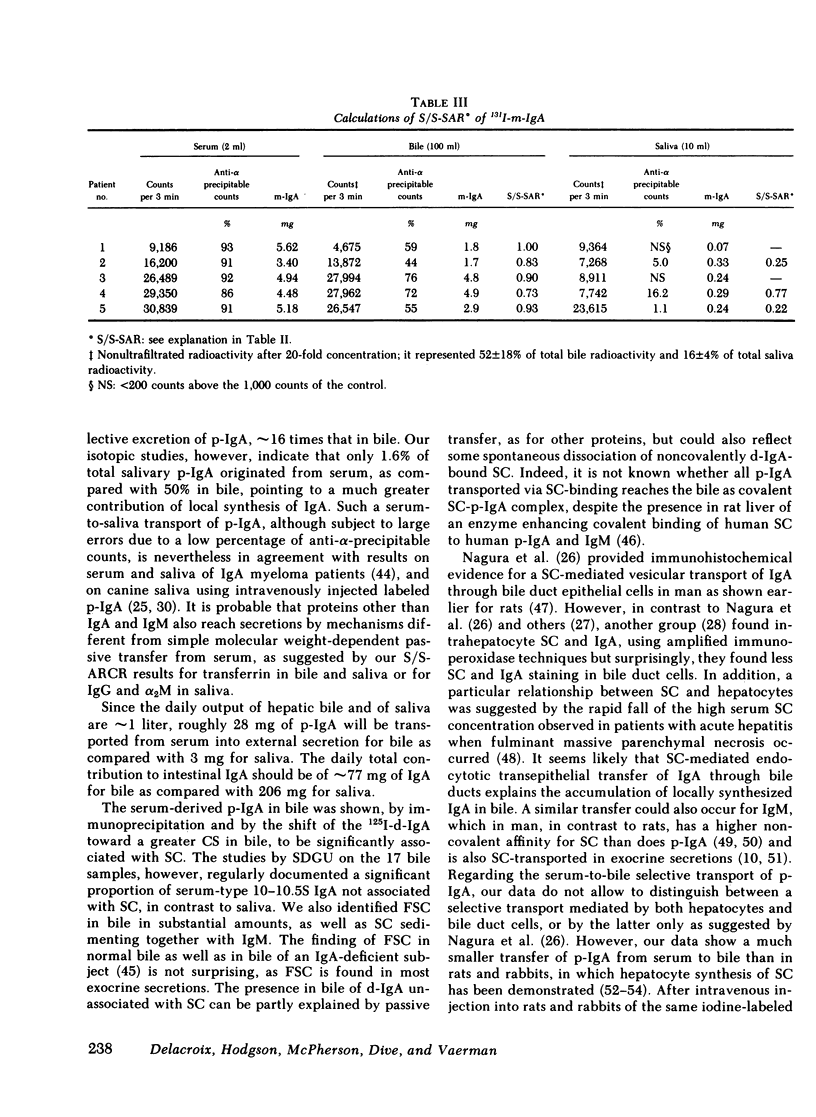
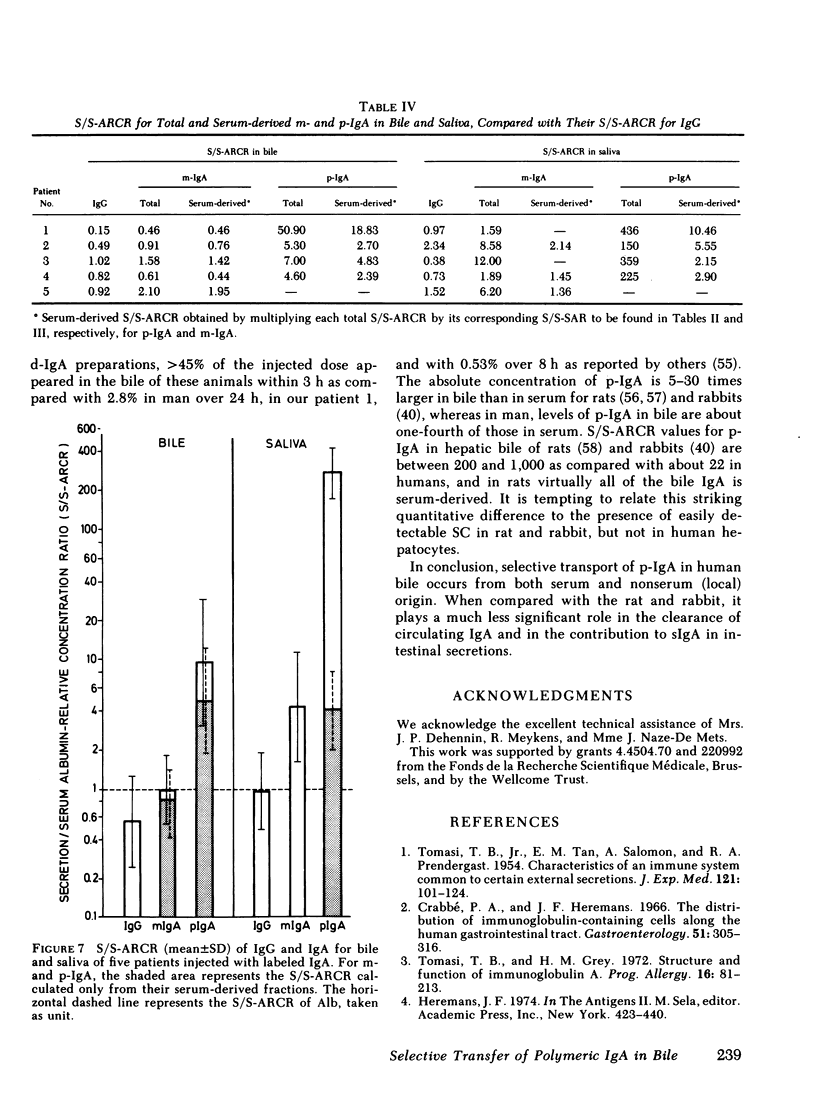
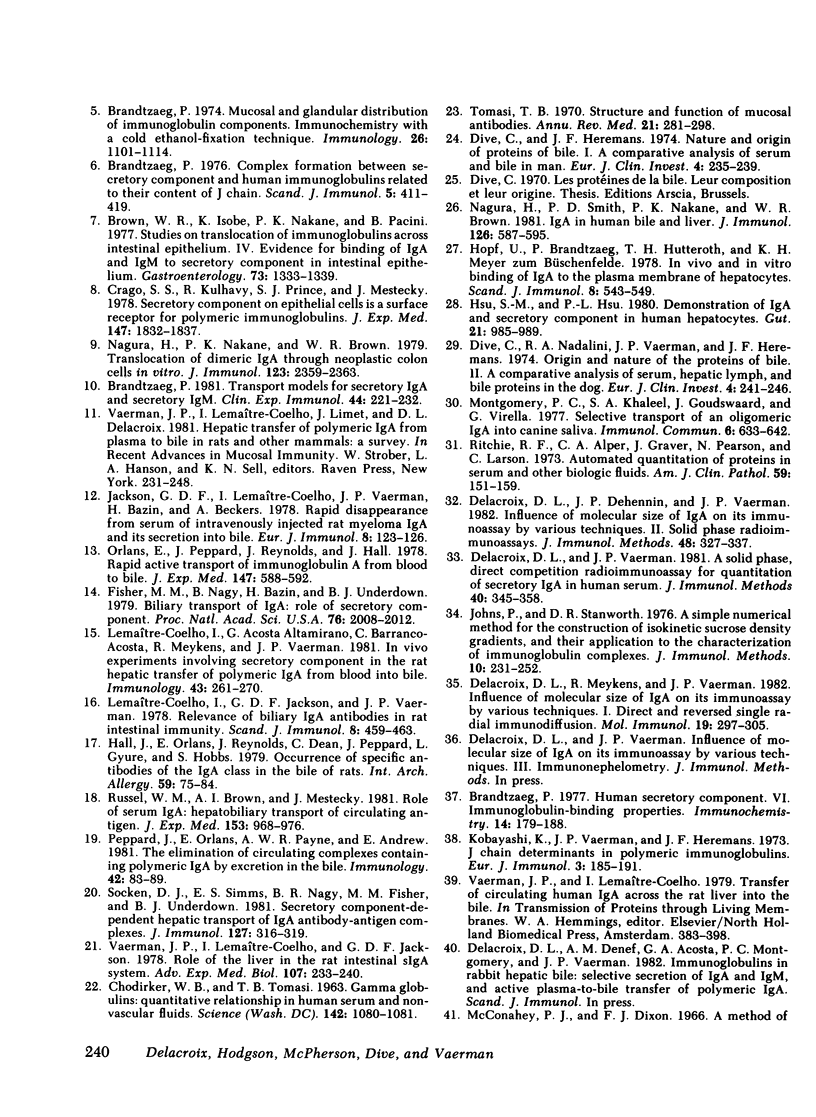
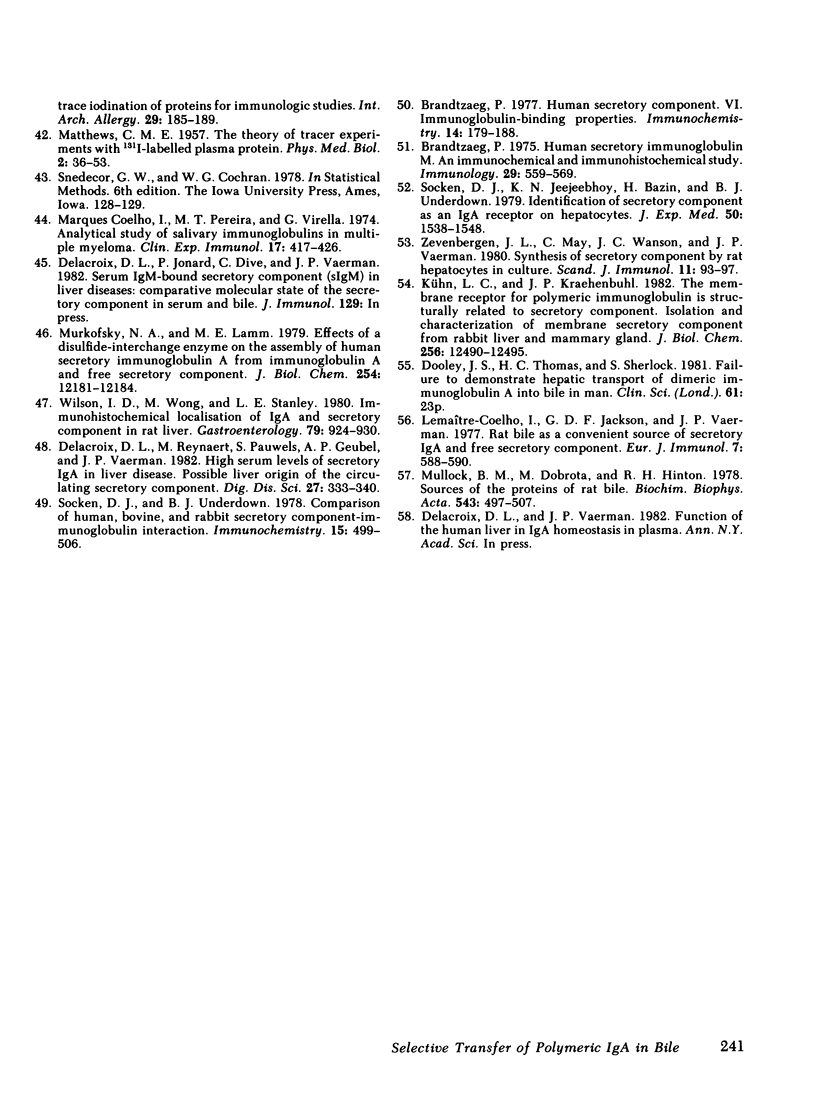
Selected References
These references are in PubMed. This may not be the complete list of references from this article.
- Brandtzaeg P. Complex formation between secretory component and human immunoglobulins related to their content of J chain. Scand J Immunol. 1976;5(4):411–419. doi: 10.1111/j.1365-3083.1976.tb00295.x. [DOI] [PubMed] [Google Scholar]
- Brandtzaeg P. Human secretory component--VI. Immunoglobulin-binding properities. Immunochemistry. 1977 Mar;14(3):179–188. doi: 10.1016/0019-2791(77)90192-6. [DOI] [PubMed] [Google Scholar]
- Brandtzaeg P. Human secretory component--VI. Immunoglobulin-binding properities. Immunochemistry. 1977 Mar;14(3):179–188. doi: 10.1016/0019-2791(77)90192-6. [DOI] [PubMed] [Google Scholar]
- Brandtzaeg P. Human secretory immunoglobulin M. An immunochemical and immunohistochemical study. Immunology. 1975 Sep;29(3):559–570. [PMC free article] [PubMed] [Google Scholar]
- Brandtzaeg P. Mucosal and glandular distribution of immunoglobulin components. Immunohistochemistry with a cold ethanol-fixation technique. Immunology. 1974 Jun;26(6):1101–1114. [PMC free article] [PubMed] [Google Scholar]
- Brandtzaeg P. Transport models for secretory IgA and secretory IgM. Clin Exp Immunol. 1981 May;44(2):221–232. [PMC free article] [PubMed] [Google Scholar]
- Brown W. R., Isobe K., Nakane P. K., Pacini B. Studies on translocation of immunoglobulins across intestinal epithelium. IV. Evidence for binding of IgA and IgM to secretory component in intestinal epithelium. Gastroenterology. 1977 Dec;73(6):1333–1339. [PubMed] [Google Scholar]
- CHODIRKER W. B., TOMASI T. B., Jr GAMMA-GLOBULINS: QUANTITATIVE RELATIONSHIPS IN HUMAN SERUM AND NONVASCULAR FLUIDS. Science. 1963 Nov 22;142(3595):1080–1081. doi: 10.1126/science.142.3595.1080. [DOI] [PubMed] [Google Scholar]
- Coelho I. M., Pereira M. T., Virella G. Analytical study of salivary immunoglobulins in multiple myeloma. Clin Exp Immunol. 1974 Jul;17(3):417–426. [PMC free article] [PubMed] [Google Scholar]
- Crabbé P. A., Heremans J. F. The distribution of immunoglobulin-containing cells along the human gastrointestinal tract. Gastroenterology. 1966 Sep;51(3):305–316. [PubMed] [Google Scholar]
- Crago S. S., Kulhavy R., Prince S. J., Mestecky J. Secretory component of epithelial cells is a surface receptor for polymeric immunoglobulins. J Exp Med. 1978 Jun 1;147(6):1832–1837. doi: 10.1084/jem.147.6.1832. [DOI] [PMC free article] [PubMed] [Google Scholar]
- Delacroix D. L., Dehennin J. P., Vaerman J. P. Influence of molecular size of IgA on its immunoassay by various techniques. II. Solid-phase radioimmunoassays. J Immunol Methods. 1982;48(3):327–337. doi: 10.1016/0022-1759(82)90333-7. [DOI] [PubMed] [Google Scholar]
- Delacroix D. L., Meykens R., Vaerman J. P. Influence of molecular size of IgA on its immunoassay by various techniques--I. Direct and reversed single radial immunodiffusion. Mol Immunol. 1982 Feb;19(2):297–305. doi: 10.1016/0161-5890(82)90343-1. [DOI] [PubMed] [Google Scholar]
- Delacroix D. L., Reynaert M., Pauwels S., Geubel A. P., Vaerman J. P. High serum levels of secretory IgA in liver disease: possible liver origin of the circulating secretory component. Dig Dis Sci. 1982 Apr;27(4):333–340. doi: 10.1007/BF01296753. [DOI] [PubMed] [Google Scholar]
- Delacroix D. L., Vaerman J. P. A solid phase, direct competition, radioimmunoassay for quantitation of secretory IgA in human serum. J Immunol Methods. 1981;40(3):345–358. doi: 10.1016/0022-1759(81)90366-5. [DOI] [PubMed] [Google Scholar]
- Dive C., Heremans J. F. Nature and origin of the proteins of bile. I. A comparative analysis of serum and bile proteins in man. Eur J Clin Invest. 1974 Aug;4(4):235–239. doi: 10.1111/j.1365-2362.1974.tb00398.x. [DOI] [PubMed] [Google Scholar]
- Dive C., Nadalini R. A., Vaerman J. P., Heremans J. F. Origin and nature of the proteins of bile. II. A comparative analysis of serum, hepatic lymph and bile proteins in the dog. Eur J Clin Invest. 1974 Aug;4(4):241–246. doi: 10.1111/j.1365-2362.1974.tb00399.x. [DOI] [PubMed] [Google Scholar]
- Fisher M. M., Nagy B., Bazin H., Underdown B. J. Biliary transport of IgA: role of secretory component. Proc Natl Acad Sci U S A. 1979 Apr;76(4):2008–2012. doi: 10.1073/pnas.76.4.2008. [DOI] [PMC free article] [PubMed] [Google Scholar]
- Hall J., Orlans E., Reynolds J., Dean C., Peppard J., Gyure L., Hobbs S. Occurrence of specific antibodies of the IgA class in the bile of rats. Int Arch Allergy Appl Immunol. 1979;59(1):75–84. doi: 10.1159/000232242. [DOI] [PubMed] [Google Scholar]
- Hopf U., Brandtzaeg P., Hütteroth T. H., Meyer zum Büschenfelde K. H. In vivo and in vitro binding of IgA to the plasma membrane of hepatocytes. Scand J Immunol. 1978;8(6):543–549. doi: 10.1111/j.1365-3083.1978.tb00554.x. [DOI] [PubMed] [Google Scholar]
- Hsu S. M., Hsu P. L. Demonstration of IgA and secretory component in human hepatocytes. Gut. 1980 Nov;21(11):985–989. doi: 10.1136/gut.21.11.985. [DOI] [PMC free article] [PubMed] [Google Scholar]
- Jackson G. D., Lemaître-Coelho I., Vaerman J. P., Bazin H., Beckers A. Rapid disappearance from serum of intravenously injected rat myeloma IgA and its secretion into bile. Eur J Immunol. 1978 Feb;8(2):123–126. doi: 10.1002/eji.1830080210. [DOI] [PubMed] [Google Scholar]
- Johns P., Stanworth D. R. A simple numerical method for the construction of isokinetic sucrose density gradients, and their application to the characterisation of immunoglobulin complexes. J Immunol Methods. 1976 Mar;10(2-3):231–252. doi: 10.1016/0022-1759(76)90174-5. [DOI] [PubMed] [Google Scholar]
- Kobayashi K., Vaerman J. P., Heremans J. F. J-chain determinants in polymeric immunoglobulins. Eur J Immunol. 1973 Apr;3(4):185–191. doi: 10.1002/eji.1830030402. [DOI] [PubMed] [Google Scholar]
- Kühn L. C., Kraehenbuhl J. P. The membrane receptor for polymeric immunoglobulin is structurally related to secretory component. Isolation and characterization of membrane secretory component from rabbit liver and mammary gland. J Biol Chem. 1981 Dec 10;256(23):12490–12495. [PubMed] [Google Scholar]
- Lemaitre-Coelho I., Jackson G. D., Vaerman J. P. Relevance of biliary IgA antibodies in rat intestinal immunity. Scand J Immunol. 1978;8(5):459–463. doi: 10.1111/j.1365-3083.1978.tb00542.x. [DOI] [PubMed] [Google Scholar]
- Lemaître-Coelho I., Altamirano G. A., Barranco-Acosta C., Meykens R., Vaerman J. P. In vivo experiments involving secretory component in the rat hepatic transfer of polymeric IgA from blood into bile. Immunology. 1981 Jun;43(2):261–270. [PMC free article] [PubMed] [Google Scholar]
- Lemaître-Coelho I., Jackson G. D., Vaerman J. P. Rat bile as a convenient source of secretory IgA and free secretory component. Eur J Immunol. 1977 Aug;7(8):588–590. doi: 10.1002/eji.1830070818. [DOI] [PubMed] [Google Scholar]
- MATTHEWS C. M. The theory of tracer experiments with 131I-labelled plasma proteins. Phys Med Biol. 1957 Jul;2(1):36–53. doi: 10.1088/0031-9155/2/1/305. [DOI] [PubMed] [Google Scholar]
- McConahey P. J., Dixon F. J. A method of trace iodination of proteins for immunologic studies. Int Arch Allergy Appl Immunol. 1966;29(2):185–189. doi: 10.1159/000229699. [DOI] [PubMed] [Google Scholar]
- Montgomery P. C., Khaleel S. A., Goudswaard J., Virella G. Selective transport of an oligomeric IgA into canine saliva. Immunol Commun. 1977;6(6):633–642. doi: 10.3109/08820137709093472. [DOI] [PubMed] [Google Scholar]
- Mullock B. M., Dobrota M., Hinton R. H. Sources of the proteins of rat bile. Biochim Biophys Acta. 1978 Nov 1;543(4):497–507. doi: 10.1016/0304-4165(78)90304-5. [DOI] [PubMed] [Google Scholar]
- Murkofsky N. A., Lamm M. E. Effect of a disulfide-interchange enzyme on the assembly of human secretory immunoglobulin A from immunoglobulin A and free secretory component. J Biol Chem. 1979 Dec 10;254(23):12181–12184. [PubMed] [Google Scholar]
- Nagura H., Nakane P. K., Brown W. R. Translocation of dimeric IgA through neoplastic colon cells in vitro. J Immunol. 1979 Nov;123(5):2359–2368. [PubMed] [Google Scholar]
- Nagura H., Smith P. D., Nakane P. K., Brown W. R. IGA in human bile and liver. J Immunol. 1981 Feb;126(2):587–595. [PubMed] [Google Scholar]
- Orlans E., Peppard J., Reynolds J., Hall J. Rapid active transport of immunoglobulin A from blood to bile. J Exp Med. 1978 Feb 1;147(2):588–592. doi: 10.1084/jem.147.2.588. [DOI] [PMC free article] [PubMed] [Google Scholar]
- Peppard J., Orlans E., Payne A. W., Andrew E. The elimination of circulating complexes containing polymeric IgA by excretion in the bile. Immunology. 1981 Jan;42(1):83–89. [PMC free article] [PubMed] [Google Scholar]
- Ritchie R. F., Alper C. A., Graves J., Pearson N., Larson C. Automated quantitation of proteins in serum and other biologic fluids. Am J Clin Pathol. 1973 Feb;59(2):151–159. doi: 10.1093/ajcp/59.2.151. [DOI] [PubMed] [Google Scholar]
- Russell M. W., Brown T. A., Mestecky J. Role of serum IgA. Hepatobiliary transport of circulating antigen. J Exp Med. 1981 Apr 1;153(4):968–976. doi: 10.1084/jem.153.4.968. [DOI] [PMC free article] [PubMed] [Google Scholar]
- Socken D. J., Jeejeebhoy K. N., Bazin H., Underdown B. J. Identification of secretory component as an IgA receptor on rat hepatocytes. J Exp Med. 1979 Dec 1;150(6):1538–1548. doi: 10.1084/jem.150.6.1538. [DOI] [PMC free article] [PubMed] [Google Scholar]
- Socken D. J., Simms E. S., Nagy B. R., Fisher M. M., Underdown B. J. Secretory component-dependent hepatic transport of IgA antibody-antigen complexes. J Immunol. 1981 Jul;127(1):316–319. [PubMed] [Google Scholar]
- Socken D. J., Underdown B. J. Comparison of human, bovine and rabbit secretory component-immunoglobulin interactions. Immunochemistry. 1978 Jul;15(7):499–506. doi: 10.1016/0161-5890(78)90080-9. [DOI] [PubMed] [Google Scholar]
- TOMASI T. B., Jr, TAN E. M., SOLOMON A., PRENDERGAST R. A. CHARACTERISTICS OF AN IMMUNE SYSTEM COMMON TO CERTAIN EXTERNAL SECRETIONS. J Exp Med. 1965 Jan 1;121:101–124. doi: 10.1084/jem.121.1.101. [DOI] [PMC free article] [PubMed] [Google Scholar]
- Tomasi T. B., Grey H. M. Structure and function of immunoglobulin A. Prog Allergy. 1972;16:81–213. [PubMed] [Google Scholar]
- Tomasi T. B., Jr Structure and function of mucosal antibodies. Annu Rev Med. 1970;21:281–298. doi: 10.1146/annurev.me.21.020170.001433. [DOI] [PubMed] [Google Scholar]
- Vaerman J. P., Lemaitre-Coelho I., Jackson G. D. Role of the liver in the rat intestinal s-IgA system. Adv Exp Med Biol. 1978;107:233–239. doi: 10.1007/978-1-4684-3369-2_28. [DOI] [PubMed] [Google Scholar]
- Wilson I. D., Wong M., Erlandsen S. L. Immunohistochemical localization of IgA and secretory component in rat liver. Gastroenterology. 1980 Nov;79(5 Pt 1):924–930. [PubMed] [Google Scholar]
- Zevenbergen J. L., May C., Wanson J. C., Vaerman J. P. Synthesis of secretory component by rat hepatocytes in culture. Scand J Immunol. 1980;11(1):93–97. doi: 10.1111/j.1365-3083.1980.tb00213.x. [DOI] [PubMed] [Google Scholar]


